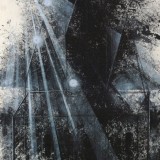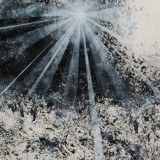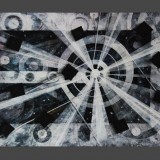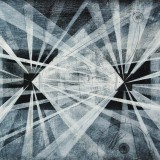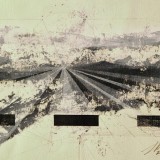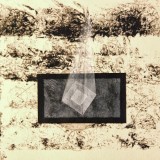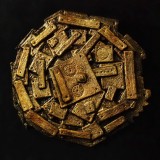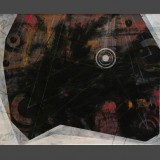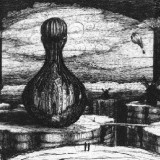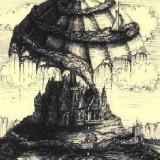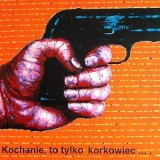Dariusz Młynarczyk
Born in Łódź, currently lives and works in Głowno, a pretty town between Łódź and Łowicz. A graduate of the Institute of Art in the Teachers’ College in Częstochowa (now Jan Długosz Academy), where in 1989 he defended his diploma in graphics supervised by prof. Ryszard Osadczy and prof. Grzegorz Banaszkiewicz. Versatile and creative, he participates in national exhibitions, competitions, workshops and auctions. His works are in private collections in Poland and abroad, he himself also collects contemporary art. The author and organiser of artistically and socially valuable projects such as the Auctions of Art by Handicapped Children and Professional Artists for the Handicapped Children’s School in Głowno, a cyclists’ portal http://tourdeglowno.blogspot.com, cyclical exhibitions of local artists Made in Głowno. Since 2011 he has run the Bank&DM Gallery in the Bank Spółdzielczy in Głowno, in which he is a curator of contemporary art exhibitions: individual and group; local, national and international.
The art of Darek Młynarczyk is varied when it comes to themes, styles and workshop techniques and it slips out of unambiguous definitions. The artist unceasingly experiments with form, acting on the border of a few domains in art to search for his own style. This constant struggle with the matter: painting, drawing, sculpture, graphics and photography which translates to new and surprising artistic qualities are the most valuable in his art. Seemingly chaotic and multidirectional searches are very consequent and come out of his rich interests and professional experiences. He started in the Studios of the Conservation of Monuments in which as a painting conservator he specialised in reconstructing gilds and polychromes for example for the Museum of the City of Łódź (1979-80), the Herbst Palace in the Księży Młyn neighbourhood in Łódź (in the 80s) the buildings in the Old Town Square in Warsaw (1986) or Koczubiej’s Palace in Saint Petersburg in Russia (1994-95).
A fascination with the glamour and decorativeness of the interiors of historical objects resulted in his using of a noble gilding technique in the series of sculptural works Machines from the series entitled Archiforms (2005-2010). The tradition was applied in innovative experiments which made reference to the futurist cult of machines, the admiration of technological achievements, the belief in the triumph of civilisation. Machines are usually central compositions, in which against a black background there are arranged spectacular, sparkling, mysteriously mixed post-industrial and biomorphic forms, set into the shapes of fish, an eye, circles, the moon, strange tools, sometimes a man-phantom. The climate of these works, maybe because of the use of gold colour, brings to mind eastern icons, and the decorative deformation of shapes overlaps onto the symbols, although the author does not impose unambiguous interpretation on the viewer. In the series of Machines there are also the artist’s variations on an Easter egg, that is sculptural objects made for yearly charity auctions “Painted with hope” organised by Caritas in Łódź (2009-2013).
Next Darek’s professional experience, as a teacher within the Handicapped Children’s School in Głowno became translated into his interest in documentary photography and his participation (with success) in a few editions of a National Photographic Competition “A handicapped child is love as he/she is, because he/she is” (2004-2008). The artist at the same time broadened the spectrum of his experiences into acrylic painting and looked for stylistic inspirations in American pop-art. A good example of such work is a large format canvas from 2005, ironically named Love, that’s only a popgun..., on which Darek demythologises and is ironic about a deadly weapon by placing it on an intensive, orange background in the convention of a street advertisement. It’s worth mentioning that this work qualified for the exhibition Painting of the Year 2005 of the Art&Business monthly, as one of the 100 best paintings in that edition of a national competition.
After pop-art there was time for his own reception of surrealism, and the effect was the series entitled Magic islands from 2005-2008, created as a computer graphic. A leading motif within this series of miniatures was a fantastic-fairylike town placed by the artist in the strangest places: on an island, moon, tree, surrounded by strange figures and unexpected shapes. Darek showed his huge imagination and temperament of a draftsman, who interestingly varies individual plans and the value and the structure of composition which excellently imitates hand-drawing. Magic islands had also commercial success, which encouraged the artist to develop further his computer-drawing experiments.
The culmination and somehow a summary of all the described experiences of this artist is Archiforms: paintings from the series Theory of seeing red, Light drawings and the above mentioned Machines, presented during the exhibition entitled Archiforms. Light-space-time... in the Museum in Łowicz at the turn of 2010 and 2011. A nice surprise was above all Light drawings – cosmic compositions on the border of geometric abstraction and luminism, in which colour minimalism became a pretext to discover the richness of nuances of light, lines, signs, patches and structures. Additional meanings were added by titles: Shining, Interferences, Accelerator or the Leonardo’s Pyramid, which pointed at the multiple planes of the artist’s inspirations. Yet more disturbing and intriguing are the newest pencil and charcoal drawings, with added acrylic paint, which are included in that series. They are monochromatic, ascetic and based on strong contrasts of black and white. The artist further courageously penetrates the dependencies of geometric figures and forms taken out of nature, strongly subjecting them to the dictatorship of lines which arrange themselves in radiuses and structure the composition. If we look at them attentively, they reveal a fantastic and disturbing architecture, strange objects, tools-machines, as if they were overexposed and subjected to constructivist vivisection. It’s a continuation of a dialogue of the artist with art history, but also science and civilisation, which entered into art once and for good and seized the imagination of artists – this is what Darek Młynarczyk’s artworks make us aware of.
Monika Nowakowska


